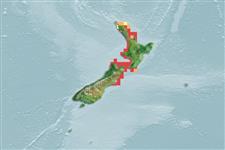>
Ovalentaria/misc (Various families in series Ovalentaria) >
Plesiopidae (Roundheads) > Acanthoclininae
Etymology: Acanthoclinus: Greek, akantha = thorn + Greek, klinein, kline = sloping and bed, due to the four apophyses of sphenoid bone (Ref. 45335).
More on author: Jenyns.
Environment: milieu / climate zone / depth range / distribution range
Écologie
marin; saumâtre démersal; non migrateur; profondeur 0 - 4 m (Ref. 9003). Temperate; 34°S - 44°S, 172°E - 176°E (Ref. 56302)
Southwest Pacific: endemic to New Zealand.
Taille / Poids / Âge
Maturity: Lm ? range ? - ? cm
Max length : 30.0 cm TL mâle / non sexé; (Ref. 9003); âge max. reporté: 9 années (Ref. 9003)
Description synthétique
Clés d'identification | Morphologie | Morphométrie
Épines dorsales (Total) : 20; Rayons mous dorsaux (Total) : 4; Épines anales: 9; Rayons mous anaux: 4.
Facultative air-breathing (Ref. 126274); Are residents of intertidal zone with homing behavior (Ref. 32612) found in pools with rocks or boulders. May leave tide pools if aquatic conditions become inhospitable (Ref. 31184). Feed mostly on invertebrates, particularly crustaceans and mollusks. They breathe air when out of water (Ref. 31184) and swim with an eel-like motion (Ref. 9003). Eggs are guarded by the male parent (Ref. 205).
Life cycle and mating behavior
Maturities | Reproduction | Spawnings | Egg(s) | Fecundities | Larves
Nests are constructed beneath boulders where the dense gelatinous cluster of about 10,000 eggs are deposited. The male stands guard and seals the nest from the inside by blocking the entrance with small stones and mud. Eggs hatch after about ten days into planktonic larvae (Ref. 9003).
Paulin, C. and C. Roberts, 1992. The rockpool fishes of New Zealand (Te ika aaria o Aotearoa). Museum of New Zealand (Te Papa Tongarewa). 177 p. (Ref. 9003)
Statut dans la liste rouge de l'IUCN (Ref. 130435)
Menace pour l'homme
Harmless
Utilisations par l'homme
Pêcheries: sans intérêt
Outils
Articles particuliers
Télécharger en XML
Sources Internet
Estimates based on models
Preferred temperature (Ref.
123201): 12.3 - 18.4, mean 16.3 °C (based on 64 cells).
Phylogenetic diversity index (Ref.
82804): PD
50 = 0.5312 [Uniqueness, from 0.5 = low to 2.0 = high].
Bayesian length-weight: a=0.00457 (0.00180 - 0.01158), b=3.10 (2.87 - 3.33), in cm total length, based on LWR estimates for this (Sub)family-body shape (Ref.
93245).
Niveau trophique (Ref.
69278): 3.6 ±0.59 se; based on food items.
Résilience (Ref.
120179): Milieu, temps minimum de doublement de population : 1,4 à 4,4 années (tmax=9).
Fishing Vulnerability (Ref.
59153): Low vulnerability (20 of 100).
